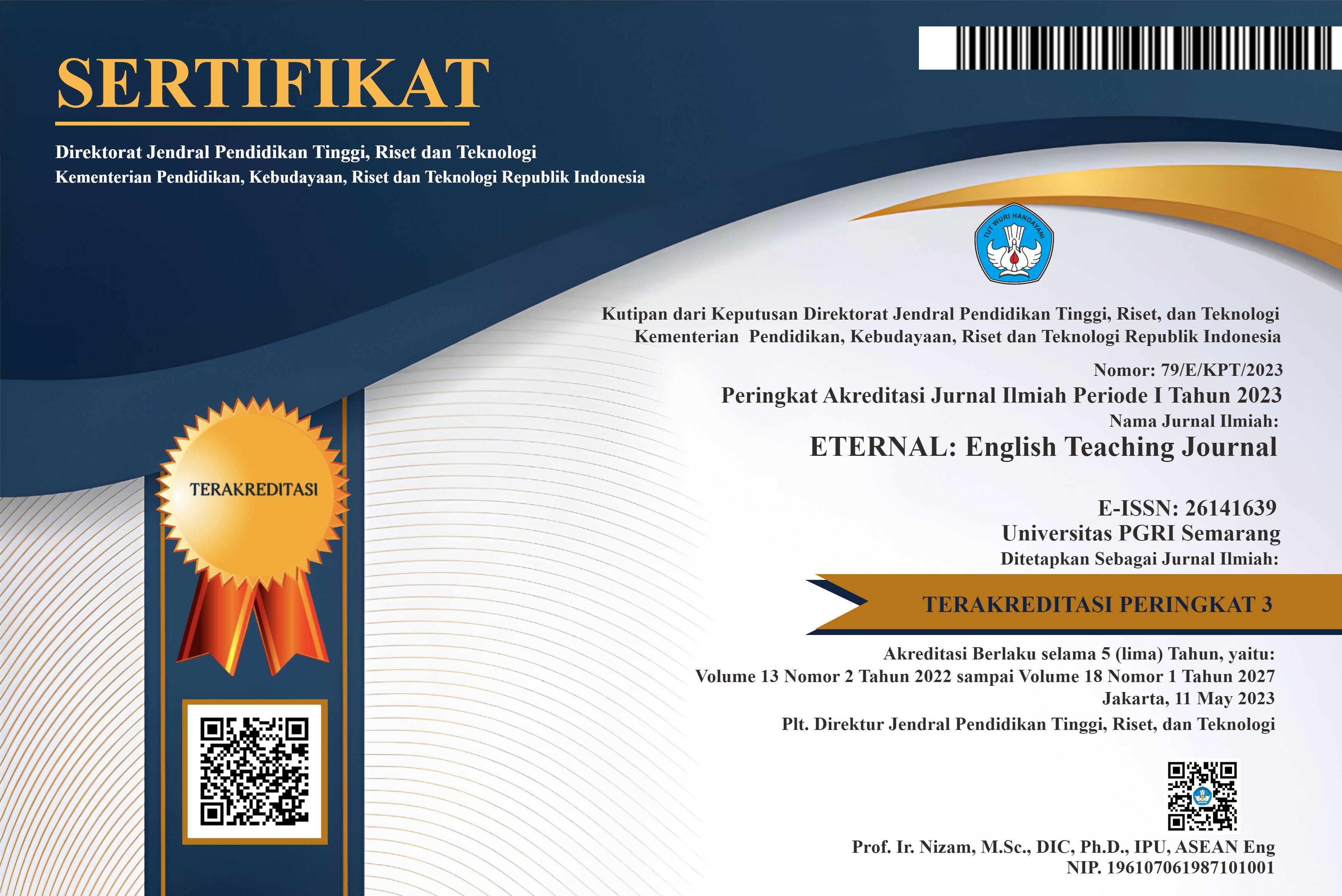Hedging Strategies in Non-Science Theses: A Corpus-Based Analysis of Discussion Sections
DOI:
https://doi.org/10.26877/eternal.v16i1.1059Keywords:
digital analysis, hedging strategyAbstract
This study aimed to investigate the academic writings of students, which were stored in the students' theses repository. The primary goal was to explore how students employ politeness and caution strategy, often referred to as academic hedging when articulating their academic opinions in Chapter IV of the discussion section within their theses. Utilizing a corpus-based approach, the study analyzed 30 theses comprising over 100,000 words. The Antconc electronic analysis application was deployed to identify patterns of sentence expression and explore how students employed hedging techniques to present their academic ideas. The results indicate that student writers tended to rely heavily on the modal "dapat" compared to other hedging devices, suggesting a potential lack of familiarity with diverse hedging methods and their appropriate use in academic writing. It is postulated that this overreliance on "dapat" might be attributed to limited exposure to alternative hedging devices in academic writing. This indicates a need for academic writing teachers in universities to equip students with comprehensive knowledge of hedges for more appropriate expression of academic ideas.
References
Adolphs, S. (2006). Introducing electronic text analysis. London: Routledge.
Bazerman, C. (1988). Shaping Written Knowledge; Essays in the growth, form function, and implications of the scientific article. Madison, WI: University of Wisconsin Press.
Bazerman, C. (2016). What Writing Does and How It Does It: An Introduction to Analyzing Texts and Textual Practices. Routledge.
Bazerman, C. (2020). Preface. In R. J. Dippre & T. Phillips (Eds.), Approaches to Lifespan Writing Research: Generating an Actionable Coherence (pp. xxi-xxiii). WAC Clearinghouse. Retrieved from https://wac.colostate.edu/books/perspectives/lifespan/
Bruner, J. (1996). The Culture of Education, Cambridge, MA: Harvard University Press.
Camiciottoli, B. (2003). Metadiscourse and ESP reading comprehension: an exploratory study. Reading in a Foreign Language 15, 28-44.
Halliday, M. A. K., & Hasan, R. (1985). Language. Context and text: Aspects of language in a social-semiotic perspective. Geelong, Australia: Deakin University Press.
Gillaerts, P. & Van de Velde, F. (2010). Interactional metadiscourse in research article abstracts. Journal of English for Academic Purposes. 9(2), 128-139. doi:10.1016/j.jeap.2010.02.004
Hyland, K. (2005). Metadiscourse: Exploring interaction in writing. London: Continuum
Halliday, M. A. K. (1978). Language as a social semiotic: The social interpretation of language and meaning. London: Edward Arnold.
Hewings, M. (Ed.). (2006). Academic writing in context: Implications and applications. London: Continuum.
Hyland, K. (2004). Metadiscourse: Exploring interaction in writing. NY: Continuum Discourse Series.
Hyland K, & Tse, P. (2004). Metadiscourse in academic writing: A reappraisal.Applied Linguistics, 25 (2), 156-177.
Jalal, F. (2009). Rendah, publikasi peneliti Indonesia di jurnal internasional. Suara Pembaharuan Daily. 1 July 2009. South East Asia : Indonesia: Interview with Dr. Fasli Jalal. Director General of Higher Education. Retrieved June 20, 2010 from / http://www.winne.com/dn interview. php?intervid=2668.
Krieger, D. (2003). Corpus Linguistics: What It Is and How It Can Be Applied to Teaching. The Internet TESL Journal 9, no. 3 (March): page nr. http://iteslj.org/Articles/Krieger-Corpus.html (accessed April 10, 2013).
Connor, E. Nagelhout, W., V. Rozycki (eds.). Contrastive rhetoric: Reaching to intercultural rhetoric (pp. 278-298). Amsterdam: John Benjamin.
Macintyre, R. (2013). Lost in a Forest All Alone: The Use of Hedges and Boosters in the Argumentative Essays of Japanese University Students. Sophia International Review. 35: 1–24.
Matsuda, P. K. & Atkinson, D. (2008). A Conversation on Contrastive Rhetoric. In U.
Meyer, P. (1997). Hedging strategies in written academic discourse: Strengthening the argument by weakening the claim. In R. Markkanen & H. Schroder (Eds.), Hedging and Discourse: Approaches to the analysis of a pragmatic phenomenon in academic text, (pp.21-41). New York: Walter de Gruyter.
Meyer, C. (2002). English Corpus Linguistics: An Introduction. Cambridge: CUP.
Mojica, L. (2005). Filipino authors' ways of showing detachment/commitment in their English academic papers. In D. Dayag & J.S. Quakenbush (Eds.), Linguistics and language education in the Philippines and beyond: a festschrift in honor of Ma. Lourdes S. Bautista, (pp. 511-525). Manila: Linguistic Society of the Philippines.
Nash, W. (1990). Introduction: The stuff these people write. In W. Nash (Ed.), The writing scholar: Studies in academic discourse (pp. 8-30). Newbury Park, CA.: Sage.
Pisanski Peterlin, A. (2005) 'Text-organising Metatext in Research Articles: An English– Slovene Contrastive Analysis', English for Specific Purposes 25: 307–19.
Prior, P. (2019). Writing and Speaking: On the Interplay of Semiotic Resources. In J. Burgess & D. Fuentes (Eds.), Handbook of Research on Writing and Speaking in Second Language Acquisition (pp. 45-62). Routledge. Retrieved from
Sinclair, J. M.(1998) Corpus evidence in language description, In Gerry Knowles, Tony Mcenery, Stephen Fligelstone, Anne Wichman, (Eds.) Teaching and language corpora. Longman pp. 27-39
Sinclair, J. M. (1997) Corpus evidence in language description. In A. Wachtman (ed.) Teaching and Language Corpora. London: Longman.
Sperling, M. & Freedman, S.W. (2001). Research on writing. In V. Richardson (Ed.), Handbook of research on teaching, (4th ed.). (pp.370-389). American Educational Research Association.
Tardy, Christine M. 2016. Beyond Convention: Genre Innovation in Academic Writing, Delves into the Complexities and Tensions of Genre in Academic Writing from Both Theoretical and Pedagogical Perspectives. Michigan: University of Michigan Press,.
Thomson Scientific (2004).Scholarly research, publishing and analysis. Retrieved March 2010 from http://thomsonreuters.com/products_services/science/ academic/.
Van Dijk, T. A. (2008). Discourse and context: A sociocognitive approach. Cambridge: CUP







